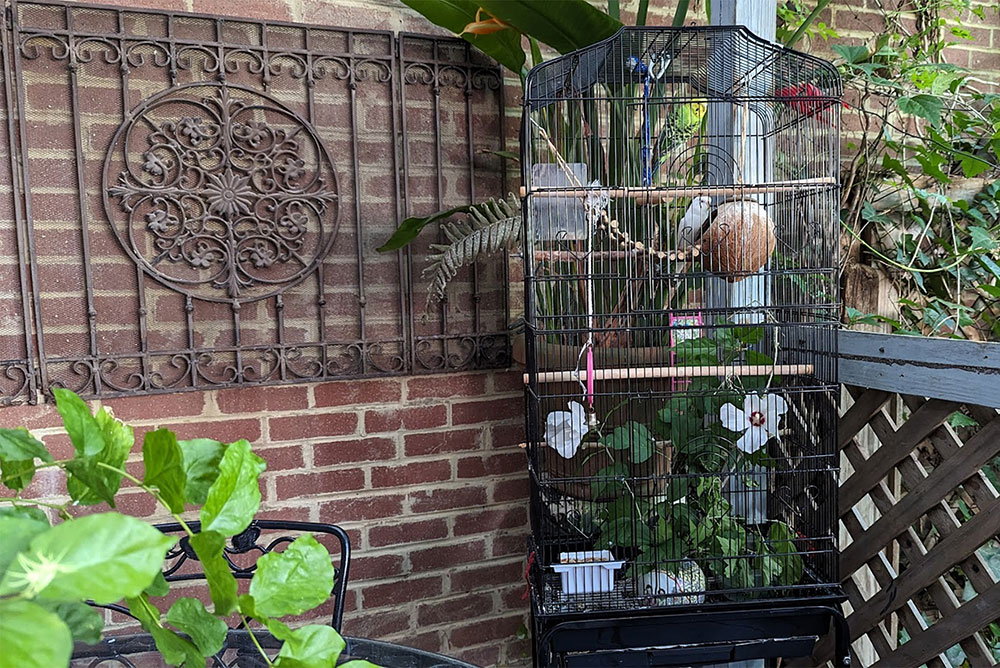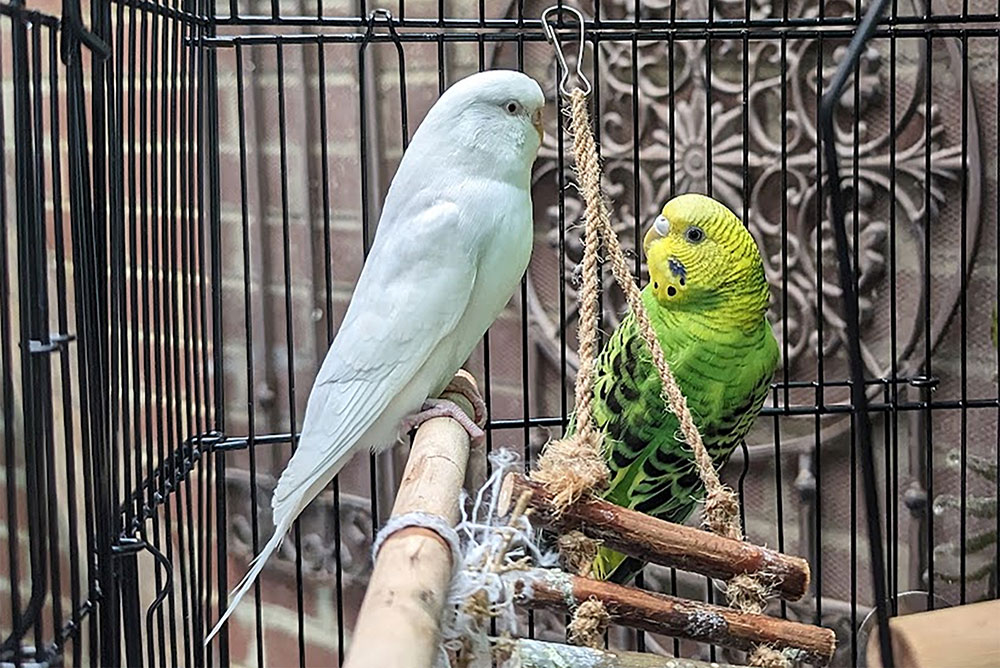COOPER MIGHT remember living in the greenhouse, flying over the jasmines, perching on the bird of paradise. Maybe not, after all she has a bird brain.
Coop is a parakeet as white as a ghost, white as a sheet, as white as snow before the dogs pee all over it. We named her after Anderson Cooper. The whitest bird we’d ever seen, named after the whitest man imaginable. We thought she was a guy bird, and then found out she’s a chick.
As I mentioned, Coop once lived in the greenhouse off my second-floor office, along with two other budgies, tragically lost. Don’t even ask. Then My Prince dismantled the greenhouse—that was well over a year ago, though we still have the idea of rebuilding bigger and grander.
Coop was in mourning—or her buddies and her free-flying habitat—until we brought Bonnie home, named for my little sister because we brought him home on her birthday. Oh, yes. Bonnie is male. *

After an Internet search confirmed which plants are safe for birds, Bonnie (top) and Coop can enjoy a garden habitat of their own. / Photo by Stephanie Cavanaugh.
They’re happy together, cuddling on branches, snuggling in the hollowed-out coconut house we’ve provided. It doesn’t seem possible, looking at them, that they could both fit in that small space, but there’s nothing much to birds but feathers. Try holding one, if you have a chance. Give it a little squeeze. They’re shockingly skinny.
I saw a photo somewhere a couple of years ago of a fine Victorian cage from Thailand, I think. A huge, ornate thing, warm wood with brass bits and a cupola. I would like that, but unless I find one on the street or in a thrift shop, anything like it would set us back thousands. This is unlikely.
Instead, the birds share a rather handsome black metal cage that in a bird’s view would be two stories, I suppose. A double-decker with a domed roof. Roomy enough for them to flutter about. We don’t let them out: When they occasionally sneak out they are nearly impossible to retrieve.
They like carrots, Edith Piaf, and being outside. Which is where I’m going with this . . .
Each morning I stock them up with food and water and roll the cage onto the back porch, pushing it tight to the rail so they can feel close to nature. They skitter about, cawing to their fellow birds, though they rarely visit, which seems strange and a little mean. While it often seems they don’t care a twig if we’re out there or not, they’ll chatter if I take the newspaper to the porch and become positively exuberant if we have guests.
So. The other day I’m having my coffee and reading the paper at the porch table and I noticed the birds nibbling the leaves of the Rose of Sharon, which butts up against the railing. I could tell this was an ecstatic experience for them because their little beady eyes rolled back in their heads and you could practically hear the moans of pleasure.
I immediately yanked them away from the rail to consult the Internet on the safety of chewing the plant and lo—it was fine. Not only that, I came across a list of plants that are perfectly safe for birds to eat, which gave me the idea of creating a garden inside the cage for them, that I started forthwith.
Filling a small Japanese vase (this just felt like an Asian thing) with florist’s foam and water, I jabbed in branches of the Rose of Sharon, which looked swell. The birds were put off by it at first but then seemed to enjoy the hide and seek-iness of the arrangement.
Maybe I’ll hang some spider-plant babies from the top rails, and plant a bottom tray with hen-and-chick succulents, and a small Boston fern—or a bouquet of leaves. They say African violets, orchids, and roses are fine too, but I have a feeling the birds are going to find them too delicious, and replacements could get costly.
A forest in the cage. Sometimes I impress myself.
*Figuring out the sex of a parakeet is not tricky, but the bird has to be at least 6 months old to make a positive ID. That’s when the cere, or hard bit around the nostrils, turns blue for boys and brown for girls. When Coop and Bonnie came home, they were too young for us to tell.


What a delightful story. A peek inside a bird’s world. I feel almost as though I know Bonnie and Coop now.
Well done, Stephanie!